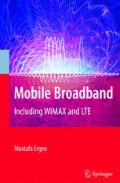Abstract
The cellular access networking has undergone a major transition in the past decade with the convergence toward OFDMA and IP technologies. Access network technologies based on these introduced by WiMAX, 3GPP, and 3GPP2 are mastered in earlier chapters with in-depth understanding of those technologies, terminology, and network configurations. Interworking of these access networks with wireline technologies is a significant step to achieve a single telecommunications network foundation. Fixed-mobile convergence (FMC) addresses this network convergence together with service convergence and device convergence in order to provide convenience and simplicity for consumers and business users to get highly featured but lower cost communications.
Access this chapter
Tax calculation will be finalised at checkout
Purchases are for personal use only
Preview
Unable to display preview. Download preview PDF.
References
Jette, A., “UMBFDD Draft Technology Overview,” IEEE 802.20 Working Group document, March 2007. http://grouper.ieee.org/groups/802/20.
Rappaport, T.S., Wireless Communications, Prentice Hall, 1996.
Cordeiro, C., Challapali, K., Birru, D., Shankar NS., “IEEE 802.22: An Introduction to the First Wireless Standard based on Cognitive Radios,” Journal of Communications, vol.1, no.1, April 2006.
Federal Communications Commision (FCC), Spectrum Policy Task Force, ET Docket no. 02-135, November 15, 2002.
Mitola, J., et al., “Cognitive Radios: Making Software Radios more Personal,” IEEE Personal Communications, vol.6, no.4, August 1999.
Haykin, S., “Cognitive Radio: Brain-Empowered Wireless Communications,” IEEE JSAC, vol.23, no.2, February 2005.
Federal Communications Commission (FCC), “Notice of Proposed Rule Making,” ET Docket no. 04-113, May 25, 2004.
DARPA ATO, Next Generation (XG) Program, http://www.darpa.mil/ato/programs/xg/.
Federal Communications Commission (FCC), “Revision of Parts 2 and 15 of the Commissions Rules to Permit Unlicensed National Information Infrastructure (U-NII) Devices in the 5GHz Band,” ET Docket No. 03-122, November 18, 2003.
Chouinard, G., “WRAN Reference Model,” IEEE 802.22, May 2005. http://www.ieee802.org/22/.
Recommendation ITU-R M.1645, “Framework and overall objectives of the future development of IMT 2000 and systems beyond IMT 2000”.
Gupta, V., Williams, M. G., Jonhston, D.J., Barber, P., Ohba, Y., “IEEE 802.21 Overview of Standard for Media Independent Handover Services,” http://www.802.org/21.
“UMA Technology Overview,” http://www.umatechnology.org/overview/index.htm.
Cudak, M., “IEEE 802.16m System Requirements,” http://wirelessman.org/tgm.
Kang, J., Boariu, A., Li, S., “Proposal for Incorporating Single-Carrier FDMA into 802.16m,” IEEE C802.16m-08/100, January 2008. http://wirelessman.org/tgm.
Tee, A., Ma, J., Fong, M. H., Jia, M., Sivanesan, K., Yu, D., Kim, S-Y., “IEEE 802.16m Multiple Access Techniques,” IEEE S602.16m-08/112rl, January 2008. http://wirelessman.org/tgm.
Mc Daid, C., “Overview and Comparison of QoS Control in Next Generation Networks,” Palo Wireless. http://www.palowireless.com/3g/qos.asp.
3GPP Standard TS 23.203 v7.1.0, “Policy and Charging Control Architecture,” December 2006. http://www.3gpp.org.
3GPP2 Draft X.S0013-012-0 v0.21.0, “Service Based Bearer Control,” April 2006. http://www.3gpp2.org.
WiMAX Forum Release 1.5 Draft, “Policy and Charging Control,” February 2008. http://www.wimaxforum.org.
In-Stat, “Wireless IP Phones Drive Future VoIP Markets,” August 2005.
FCC Cognitive Radio Technologies Proceedings, http://www.fcc.gov/oet/cognitiveradio.
Author information
Authors and Affiliations
Rights and permissions
Copyright information
© 2009 Springer Science+Business Media, LLC
About this chapter
Cite this chapter
Ergen, M. (2009). Drivers of Convergence. In: Mobile Broadband. Springer, Boston, MA. https://doi.org/10.1007/978-0-387-68192-4_13
Download citation
DOI: https://doi.org/10.1007/978-0-387-68192-4_13
Published:
Publisher Name: Springer, Boston, MA
Print ISBN: 978-0-387-68189-4
Online ISBN: 978-0-387-68192-4
eBook Packages: EngineeringEngineering (R0)

